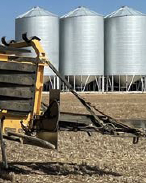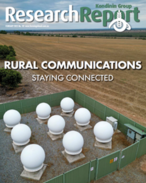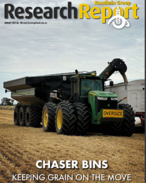This article is 7 years old. Images might not display.
RLN feed on crop roots and extract key nutrients from the plant, which can result in significant yield losses particularly in wheat and chickpea.
The main species present in the northern region are Pratylenchus thornei and P. neglectus. Correct identification underpins successful paddock management, as different RLN species have different host ranges and there are even different responses within crop varieties.
In the northern region, two P. thornei nematodes per gram of soil at planting has been found to cause significant damage in intolerant wheat varieties. At its worst, planting intolerant wheat varieties can result in up to 60 per cent yield losses.
Testing for RLN is carried out by the DNA-based PREDICTA B service, which stemmed from GRDC investments. It is provided by the South Australian Research and Development Institute (SARDI), a division of Primary Industries and Regions South Australia (PIRSA).
The PREDICTA B laboratory is closed for an extensive renovation, but is expected to be operational in early February 2018. Soil samples can still be submitted before this date. However, all samples will be stored in SARDI facilities until processing recommences.
WHY TEST FOR RLN?
Dr Alan McKay, the leader of SARDI’s Soil Biology and Molecular Diagnostics group, was in Queensland and New South Wales recently presenting an accreditation course to local agronomists, enabling them to deliver PREDICTA B services to their clients.
He says PREDICTA B testing in the northern region has shown P. thornei is widespread, particularly in deep, well-structured soils, where crops are grown on stored moisture. P. thornei can feed on roots throughout the soil profile, which reduces the ability of crops to utilise stored soil moisture.
P. neglectus also occurs right across the northern region and is usually found in the top 10cm of soil.
Dr McKay says the risk of crop damage from RLN is more likely where growers:
- carry out intensive cereal-pulse rotations;
- sow crops late;
- growing intolerant cereal varieties leads to the biggest losses from RLN.
Dr McKay says symptoms of RLN noted in-crop during 2017 may have included:
- slow emergence and establishment;
- stunting and poor tillering (cereals);
- delayed maturity and wilting plants despite good soil moisture; and
- irregular crop growth across, or patchy growth, in paddocks.
It is important to know which species of RLN are present because different crops and varieties vary in tolerance (performance under pressure of RLN) and resistance (genetic susceptibility) to each of the nematode species. Rotations and variety choices that control one species of RLN may not effectively control another.
HOW TO TEST FOR RLN
Dr McKay says the use of an accredited agronomist or adviser is required to ensure the correct sampling protocol is followed for PREDICTA B testing and interpretation of results.
SARDI can provide contacts for accredited advisers by emailing: nigel.percy@sa.gov.au or alan.mckay@sa.gov.au
For best test results:
- Use PREDICTA B soil sample kits from SARDI.
- Map a sample zone in each paddock and take three soil core samples at 15 locations.
- Collect cores from along the row of the previous cereal crop (up to 500 g/sample).
- Send to SARDI for analysis.
MANAGEMENT OPTIONS FOR RLN
If RLN are detected in paddocks, the PREDICTA B manual, which is provided to accredited agronomists, contains information about management options based on the crop yield loss risk. Accredited agronomists develop specific recommendations appropriate for individual growers.
RESEARCH INTO RLN IN QLD AND NSW
Over the past decade GRDC investment projects carried out by research partners, such as the University of Southern Queensland (USQ) and the Queensland Department of Agriculture and Fisheries (QDAF) have investigated RLN incidence, potential yield losses, management and variety tolerance/resistance (mostly in cereals).
USQ nematologist Dr Kirsty Owen says the risks of yield loss from RLN in Queensland and New South Wales are related to RLN densities at planting and the intolerance of a crop variety.
But she says RLN numbers could increase rapidly and catch growers by surprise.
Dr Owen says if medium or high RLN densities (greater than 2 per gram soil) are detected, growers need to select tolerant cereal varieties to minimise grain yield losses, and choose rotations that reduce RLN populations in the soil for future crops.
“If nematode populations are high, two or more consecutive resistant crops will be needed to reduce numbers to low levels,” she says.
“Growers should also attempt to implement, in parallel, control strategies for RLN and crown rot. They should also keep in mind that even moderately tolerant varieties may suffer yield losses when RLN are very high.”
In the northern region, crops with good resistance to both P. neglectus and P. thornei include sunflower, cotton and some varieties of maize.
But growers should note that susceptible crops can be tolerant, with barley, soybean and mungbean susceptible but tolerant to P. thornei, while sorghum is susceptible, but tolerant to P. neglectus.
For P. thornei, some cereal varieties can be good break options with grain sorghum, millet, cotton and sunflower poor hosts of P. thornei.
For P. neglectus, research has found planting break crops, such as faba bean, sunflower, soybean, mungbean and cotton can assist in reducing P. neglectus populations.
LEARN MORE AT THE GRDC UPDATES
Dr Owen will provide new research into chickpeas and wheat, looking at P. thornei build-up and decline in the farming system and the impact of chickpeas susceptibility and moderate tolerance to P. thornei at the northern region GRDC Grains Research Updates early in 2018.
She will present her research findings at the GRDC Grains Research Updates in Wee Waa (Imperial Hotel) on March 1 and at Goondiwindi (Community Cultural Centre) on March 6 and 7.
Growers are also encouraged to attend the 2018 GRDC NSW and Queensland Updates being held at:
- Wagga Wagga, NSW – February 13 and 14
- Corowa, NSW – February 15
- Dubbo, NSW – February 27 and 28
- Breeza, NSW – March 2
- The Rock, NSW – March 15
- Goondiwindi, QLD – March 6 and 7
- Allora, QLD – March 8
Contact:
Dr Alan McKay, PREDICTA B
08 8303 9375
Dr Kirsty Owen, USQ
GRDC Project Codes:
UAS00137, DAV00128; DAW00245, GIA0004
Useful Resources:
GRDC-supported Broadacre Soilborne Disease Manual
Soil testing critical step in nematode control GroundCover article
GRDC Tips and Tactics: Root Lesion Nematodes (northern region)
PREDICTA B soil testing article






















